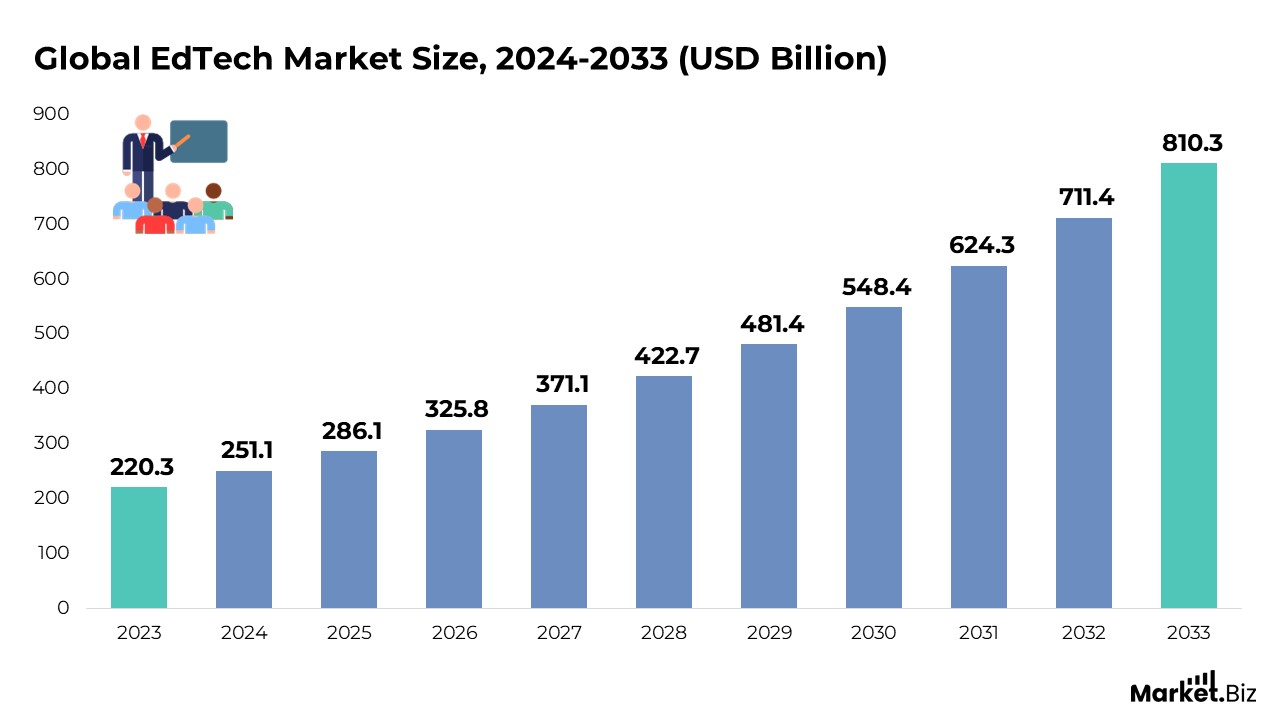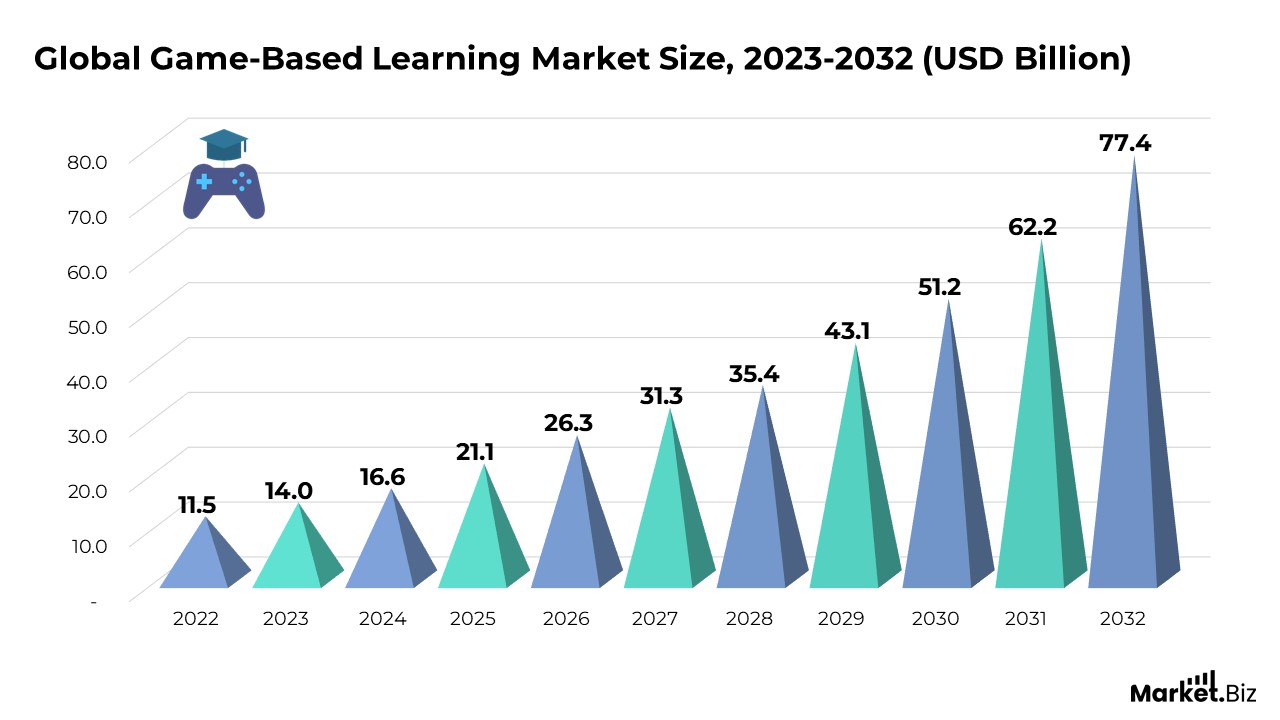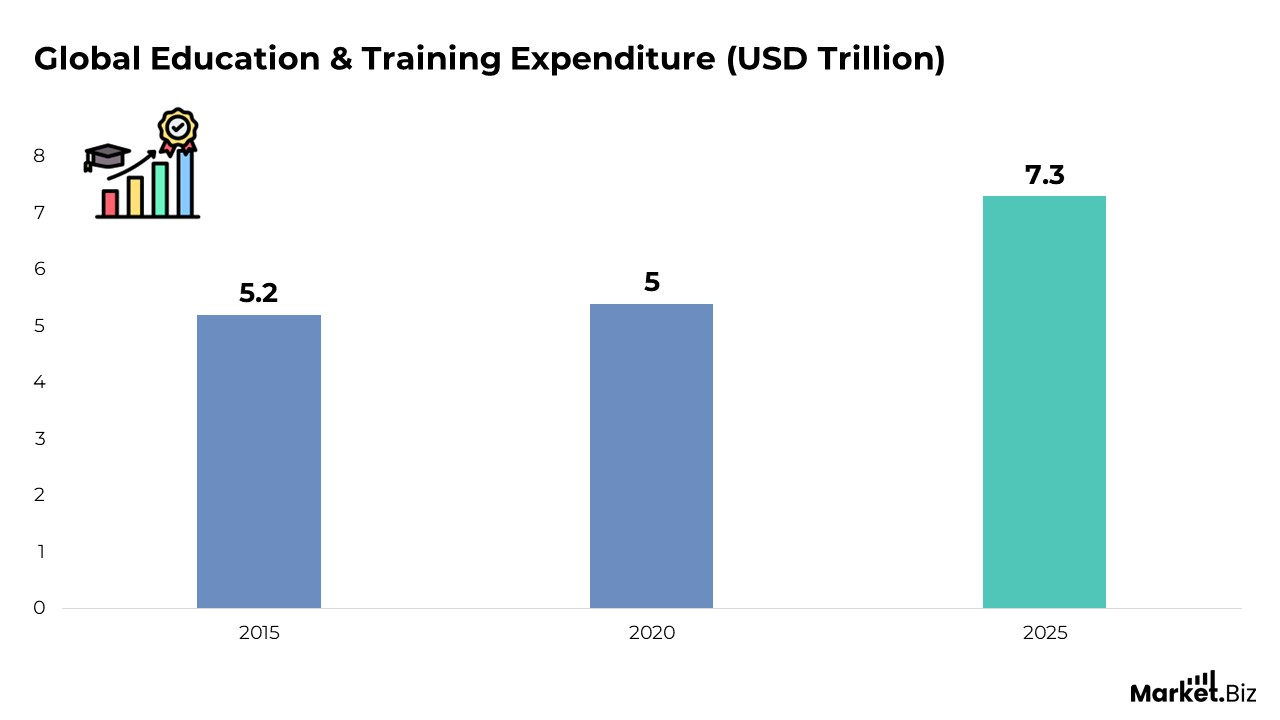Introduction
EdTech Statistics: The EdTech sector has experienced significant growth in recent years, driven by technological advancements, shifting learning needs, and a growing demand for flexible and accessible education options. The integration of digital tools and platforms is making education more personalized, interactive, and data-driven. From virtual classrooms to AI-enhanced tutoring systems, EdTech is transforming the way students learn, educators teach, and institutions function.
As schools, universities, and organizations increasingly incorporate Technology to improve learning experiences, the impact of EdTech is evident across K-12 education, higher learning, and corporate training. This evolution is not only expanding access to quality education but also fostering innovation, engagement, and continuous learning. The following statistics provide insights into the key trends shaping the future of EdTech.
Editor’s Choice
- By the end of 2023, the number of mobile learning EdTech users is expected to reach 2.5 billion.
- Virtual Reality (VR) and Augmented Reality (AR) are responsible for approximately 15% of the total revenue in the EdTech industry.
- The K-12 sector contributes 55% of the total revenue in the EdTech market.
- EdTech, particularly eLearning, has the potential to increase information retention by 25% to 40%.
- 84% of learners report feeling more engaged with gamified EdTech solutions.
- 61% of HR leaders believe that online credentials are equally valuable as traditional in-person qualifications.
Global EdTech Market Size

- According to Market.us, the global EdTech market is estimated to grow from $286.1 billion in 2025 to $711.4 billion by 2032, representing a compound annual growth rate (CAGR) of 13.9% from 2024 to 2033.
- The EdTech market is growing due to the rising demand for accessible, flexible, and personalized learning, with significant investments from educational institutions and corporations.
- On-premise solutions led the deployment models, capturing 70.8% of the EdTech market share in 2023.
- Hardware solutions accounted for 40.7% of the market share, reflecting the continued need for physical educational tools and devices.
- The K-12 sector held the largest share in the education segment, representing 55.9%, indicating the early Adoption of Technology in schools.
- The Business segment accounted for 68.1% of the EdTech market, driven by corporate training and upskilling programs.
- North America led the EdTech market in 2023, accounting for 37.7% of the share and generating revenues of USD 82.24 billion.
- The Middle East & Africa region captured 31.0% of the market, supported by increasing digital literacy and government initiatives.
- Europe accounted for 29.6% of the EdTech market share in 2023, maintaining a strong presence in the sector.
- The Asia-Pacific region held a 24.1% share of the EdTech market, driven by rapid digitalization and increasing demand for high-quality educational services.
- Latin America had a smaller 5.9% share, indicating the gradual Adoption of EdTech solutions in the region.
(Source: Market.us)
Global Game-Based Learning Market Size

- According to Market.us, the global game-based learning market is projected to grow from $21.1 billion in 2025 to $77.4 billion by 2032, representing a compound annual growth rate (CAGR) of 21.6% from 2022 to 2032.
- The growth of the game-based learning (GBL) market is driven by its proven effectiveness in boosting student engagement, motivation, and learning outcomes.
- GBL enhances critical skills such as problem-solving, strategic thinking, and teamwork, making it an essential tool for both education and professional development.
- The Solution Segment dominated the market, accounting for a 58% share in 2022, reflecting the high demand for modern educational approaches.
- The Training, Knowledge, & Skill-Based Games Segment held 25% of the market in 2022, highlighting the preference for games that foster knowledge and skill development in educational settings.
- The On-Premises Segment led the market in 2022, offering benefits such as enhanced security, customization, and flexibility, particularly in corporate training and development.
- The Enterprise Segment captured 32% of the market in 2022, showcasing the role of GBL in setting performance goals and promoting problem-solving skills in the workplace.
- North America is projected to be the largest market for game-based learning, with a 38.5% market share, driven by high adoption rates among teenagers, widespread smartphone use, and economic improvements.
(Source: Market.us)
Global EdTech Statistics
- 36% of teachers are familiar with the term “EdTech” but do not fully understand its meaning.
- 14% of teachers have never encountered the concept of educational Technology.
- 60% of academy school teachers believe there is insufficient training available for integrating EdTech into classrooms.
- 37% of teachers in the UK have personally purchased tech supplies for their students.
- 79% of teachers report using EdTech tools daily.
- Education represents one of the world’s largest industries, contributing over 6% to global GDP. Total global spending by governments, businesses, and consumers is projected to reach $7.3 trillion by 2025.
- The education sector is valued at $6.5 trillion but is still in the early stages of its digital transformation.
- The use of EdTech in K-12 schools has surged by 99% since 2020.
- By 2050, the number of school, college, university, and alternative post-secondary graduates is expected to increase by 2 billion globally, primarily driven by higher participation rates and population growth.
- Global spending on EdTech is projected to experience substantial growth in key areas, with investments in augmented and virtual reality expected to rise from $1.6 billion in 2018 to $12.6 billion by 2025.
(Source: Global EdTech, BlueTree, Holon IQ)
Global Education & Training Expenditure

College EdTech Statistics
- Over 70% of colleges plan to introduce at least one online undergraduate program within the next three years, indicating a growing shift towards digital education and the demand for flexible learning options.
- 80% of college students report that EdTech solutions have helped improve their grades, and over 80% say these tools enhance their studying efficiency, increase study time, and improve learning outcomes.
- Technology plays a crucial role in shaping students’ study habits, with 70% of students considering mobile electronic devices essential for their academic work, underscoring the importance of learning on the go.
- Nearly 90% of college students feel that EdTech solutions should be personalized to match their individual learning styles, underscoring the growing demand for adaptable and customizable learning tools.
- About 70% of students use mobile Technology, mainly Apple devices, for school-related tasks, with popular tools like Google Docs, Zoom, and Microsoft Word being commonly used for academic purposes.
- 81% of students agree that Technology is vital for completing homework, reflecting its integral role in facilitating learning beyond the classroom.
- 79% of students believe that Technology significantly aids in preparing for exams and tests, showcasing its importance in enhancing study and revision processes.
- 71% of students strongly feel that Technology increases their engagement with course content, highlighting how digital tools can make learning more interactive and captivating.
- 58% of professors believe that Technology is beneficial in the teaching process, recognizing its positive impact on enhancing educational delivery and classroom experiences.
(Source: Education Resources Information Center, BlueTree, info DOCKET)
Impact and Adoption of eLearning Technology
- 81% of U.S. college students report that eLearning Technology has contributed to improving their grades.
- 75% of U.S. schools plan to transition to fully online operations soon.
- eLearning has been shown to reduce energy consumption by 90%, offering significant environmental benefits.
- Over 80% of online activity is driven by video content, with the majority focused on educational or training-related materials.
- 80% of schools are either purchasing or planning to purchase additional Technology to support students’ learning needs.
- 79% of teachers believe that Technology enhances the learning experience, making it more engaging.
- Students retain 25% to 60% more information through online courses compared to traditional classroom settings.
- Approximately 40% of Fortune 500 companies utilize eLearning platforms for employee training.
- 67% of companies provide eLearning opportunities through smartphones, facilitating on-the-go learning.
(Source: Zhou Ventures, Inc., eLearning Industry, Skill Scounter, Shift Learning)
Online Learning Statistics
- The United States is expected to generate $74.8 million in online learning revenue this year.
- Over 30% of American students have enrolled in at least one online course.
- 63% of students prefer online learning for its flexibility and convenience.
- K-12 online learning devices meet antivirus compliance standards only 60% of the time.
- Students pursuing four-year degrees are more likely to take online courses compared to those in 2-year programs.
- 77% of public college students participate in at least one online course.
- 49% of full-time faculty members have received training in online learning methodologies.
(Source: Statista, Taylor & Francis Online, Bay Atlantic University, Peck Consulting LLC, National Center for Education Statistics)
K-12 EdTech Statistics
- In the 2022–23 academic year, Google Classroom emerged as the most widely used learning management platform among K-12 educators and students across the United States.
- A 2022 study revealed that digital engagement in K-12 EdTech was distributed as follows: 17.5% was geared towards organizational tools, 22.5% directed at teacher resources, and 60.0% centred on student interaction.
- · In 2023, the shift toward digital learning in K-12 education gained momentum due to improved internet accessibility worldwide. Estimates suggested that more than 5.8 billion individuals would be connected online, including 1 billion with access to 5G networks, contributing to the broader Adoption of e-learning models.
- The combined population of K-12 and higher education students is forecasted to rise from 310 million in 2020 to between 320 and 325 million by 2025, reflecting a steady annual growth rate of approximately 2%.
(Source: Statista, PWC, Hurix).
How does Technology Influences Educational Outcomes?
- In North America, the use of data projectors during classroom instruction yields better learning outcomes than laptops, tablets, or desktop computers.
- Around 32% of educators in the U.S. find smartphones to be the most effective tool for student assignments.
- Introducing gamified learning methods can boost academic performance by approximately 45.4%.
- Educational platforms that employ challenge-based gamification techniques can enhance learning outcomes by nearly 89.4%.
- Nearly 53% of teachers report that giving each student access to a personal computer significantly improves the ease and effectiveness of teaching, particularly for curriculum delivery.
(Source: Get Stream)
Global Trends in Student Preferences and Online Learning
- Ninety-two per cent of students worldwide express interest in personalized support and tracking of their degree progress.
- Approximately 56% of students globally want their instructors to encourage the use of laptops more for learning purposes.
- Around 65% of educational faculty support incorporating open educational resources (OERs) into their teaching methods.
- 49% of students reported having taken an online course in the past year.
- 47% of students initiated their first online course within the last year.
- 73% of students globally are unaware of massive open online courses (MOOCs).
- 19% of students stated they would include competency-based digital badges on their resumes.
(Source: Getstream, Statista, eLearning Industry, Chegg)
Technologies Utilized in Modern Classrooms: A U.S. Perspective
- 71% of U.S. Students report using laptops in the classroom, significantly higher than the global average of 37%.
- 56% of U.S. Students use laptops at least once a week for educational purposes.
- As of April 2020, only 2.5% of U.S. K-12 students accessed online learning from home via district-provided internet.
- Mobile Technology enhances students’ ability to seek assistance and engage in collaborative learning, positively impacting subjects such as literacy, mathematics, science, art, and history.
(Source: Statista, USA Facts)
Recent Developments
Technological Trends:
- AI-Powered Learning: Artificial intelligence is revolutionizing EdTech by delivering personalized learning experiences and virtual tutoring services. Tools like ChatGPT are being integrated to support students in writing, language learning, and other academic areas.
- Augmented Reality (AR) and Virtual Reality (VR): AR and VR technologies are increasingly employed to create immersive educational experiences, helping students grasp complex concepts through interactive simulations and virtual environments.
Regulatory and Strategic Developments:
- Blockchain for Credential Verification: Blockchain technology is being adopted to securely store academic records, ensuring the authenticity of qualifications and simplifying the sharing of verified credentials.
- Simplification of EdTech Tools: Schools are reducing the number of EdTech tools they use, aiming to simplify operations, enhance cybersecurity, and focus on integrating a smaller number of more effective platforms.
Conclusion
The EdTech sector is witnessing continuous growth, driven by rapid technological advancements that are reshaping the educational landscape. It holds the promise to redefine teaching and learning by enhancing accessibility and enabling more tailored learning experiences. With the ability to support individualized learning paths, EdTech empowers students to progress at their own pace and according to their learning preferences. This personalization is a key factor in enhancing educational outcomes and improving student engagement.
Despite its benefits, the Adoption of EdTech comes with notable challenges. Limited internet access remains a major barrier, especially in underserved regions. Moreover, disparities in the quality of digital content raise concerns about the equitable provision of learning experiences. Nonetheless, the ongoing digital transformation in education is accelerating the Adoption of EdTech. As innovation continues, EdTech is well-positioned to drive meaningful change and create more inclusive and effective education systems.
FAQ’s
EdTech, short for educational Technology, involves using digital platforms and tools to improve the learning experience and streamline educational processes. It plays a crucial role in making education more accessible, engaging, and effective across different learning environments.
The EdTech market is expanding rapidly worldwide, driven by increasing internet access, the growing use of smartphones and tablets, digital integration in schools, and a rising preference for customized and remote learning options.
Primary drivers include K–12 schools, universities, and corporate training programs. K–12 education, in particular, is rapidly embracing technologies such as learning management systems, interactive digital content, and gamification.
Notable trends shaping the sector include the rise of hybrid learning formats, the use of gamified content, the integration of AI for personalized education, and the surge in mobile-based learning platforms.
Key obstacles include inconsistent internet connectivity, privacy and data protection issues, a lack of digital skills among users, and concerns over content quality and accessibility in digital learning environments.
